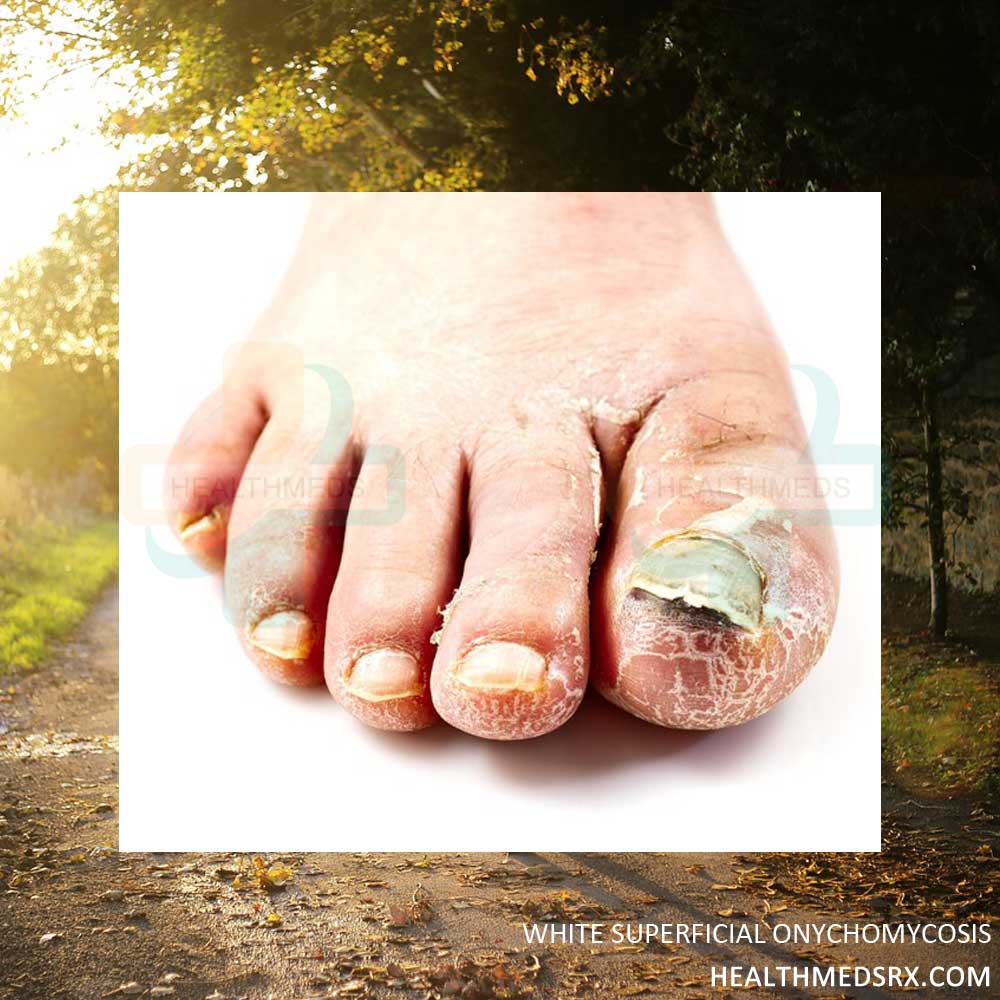White Superficial Onychomycosis (WSO) is an unequivocal type of fungal nail infection that specifically targets the surface layers of the nails. Unlike other forms of onychomycosis, WSO specifically targets the superficial layers of the nail plate, resulting in a characteristic white discoloration and powdery appearance. This condition is caused by dermatophytes, fungi that thrive in warm and moist environments. WSO often occurs in individuals with weakened immune systems, as well as those who frequently expose their nails to moisture or trauma. It is crucial to diagnose and treat nail infections promptly to prevent them from spreading and causing further damage.
Symptoms of White superficial Onychomycosis:
- White or yellowish spots on nails. These patches may start at the tip or side of the nail before spreading to the nail bed. This discoloration is caused by the accumulation of keratin deposits under the nail.
- Symptoms of white superficial onychomycosis(WSO) include the appearance of white, chalky powdery patches on the nail surface.
- The affected area can expand and cover a large part of the nail bed, making it appear discolored and opaque.
- The affected part of the nail may become brittle and flaky. As the infection spreads, the nails become deformed, split, or crumble.
- Affected nails may also thicken or become distorted in shape.
- It is important to note that WSO does not usually cause pain or discomfort, but if left untreated, it can gradually cause further damage to the nail.
Causes of White Superficial Onychomycosis
- Trichophyton Mentagrophytes – This fungus naturally lives on the human body and is commonly found in soil. An overgrowth of it can lead to fungal nail infections. It thrives in warm, humid environments.
- Tinea Unguium – Onychomycosis, also known as ringworm of the nail, is a fungal infection that affects the nail bed and nail plate.
Diagnosis
The diagnosis of White Superficial Onychomycosis (WSO) typically involves a combination of clinical examination and laboratory tests. A thorough visual examination of the affected nails by a healthcare professional is necessary to identify characteristic signs such as white chalky patches or discoloration. They may also take a small sample of the nail for further analysis in a laboratory. To identify the exact fungi that cause the infection, it’s crucial to examine the nail sample under a microscope or subject it to fungal culture. This helps in confirming the diagnosis and determining the appropriate treatment approach. Seeking medical advice is important for an accurate diagnosis and appropriate management of WSO.
Treatment
There are several treatment options for white superficial onychomycosis:
- Topical antifungal creams
- Oral antifungal medications
- Laser therapy
- Nail removal
Natural Remedies
Some natural remedies may help treat white superficial onychomycosis.
- Tea Tree Oil-Tea tree oil, with its antifungal and antiseptic properties, can help fight fungal nail infections. Apply undiluted tea tree oil directly to affected nails using a cotton swab or brush 1-2 times per day.
- Oregano Oil-Oregano oil has antifungal and antibacterial effects. Before applying to nails, dilute with a carrier oil like olive oil, coconut oil, or jojoba oil. The carvacrol and thymol compounds in oregano combat fungus and infection.
- Apple Cider Vinegar-Apple cider vinegar can be used to treat fungal nail infections due to its acetic acid content which can kill fungus and bacteria.
Prevention
The most effective way to prevent white superficial onychomycosis is to practice good nail hygiene and avoid conditions that allow the fungus to thrive. Here are some tips:
- Keep nails dry.
- Trim nails properly
- Wear appropriate footwear
- Protect your feet
- Choose breathable materials
- Practice good foot hygiene
- Avoid sharing personal items
- Maintain Healthy Hygiene Conditions
Complications
If left untreated or relapsing, white superficial onychomycosis can lead to several complications:
- The fungal infection may never fully clear and keep coming back periodically even after treatment. The toenails and fingernails can get repeatedly infected.
- As the fungus persists, it can more easily spread from the infected nails to other nails on the hands and feet. It may also spread to other people through direct contact or by touching objects that carry the fungus.
- As the infection damages the nail, it may become painful or uncomfortable. Thickened, brittle nails are prone to cracking or separating from the nail bed, which causes pain.
- Over time, the fungal infection can cause the nails to become dis-colored, distorted, opaque, crumbly, and detached from the nail bed.
- If the fungal infection spreads to infect multiple toenails, it can impair a person’s ability to walk normally. The disfigured thick nails may press against the inside of shoes causing discomfort.
Prognosis
Generally, the prognosis for white superficial onychomycosis is good with proper treatment. It may take several months for the infection to be fully cleared from the nail and for the nail to grow out normally again.
With oral antifungal medication, white superficial onychomycosis can often be cured within 6-9 months as the nail grows out. Topical treatments may take longer, closer to 12 months. Even after treatment is completed, there is a higher risk of recurrence compared to other forms of onychomycosis. Therefore, diligent follow-up care and monitoring is important.
Some key factors that influence prognosis include:
Area of infection – Smaller infected regions tend to respond better to treatment than larger areas.
Severity – If the infection is allowed to worsen untreated, it becomes more difficult to cure.
Type of treatment – Oral medications have higher cure rates than topical agents alone.
Patient compliance – Taking medications consistently as directed and following prevention tips improves prognosis.
Overall health – Those with weakened immune systems or diabetes may have a poorer response to treatment.
With timely diagnosis, proper treatment, and patient self-care, the prognosis for white superficial onychomycosis is generally positive. Yet recurrence is possible if preventive steps are not maintained. Working closely with a dermatologist is key to ensuring the best outcome.


